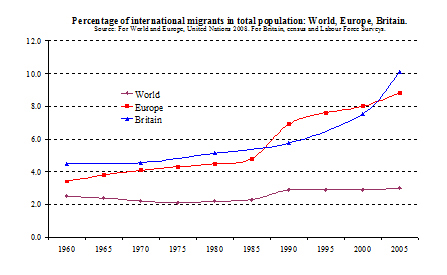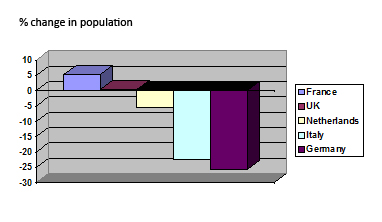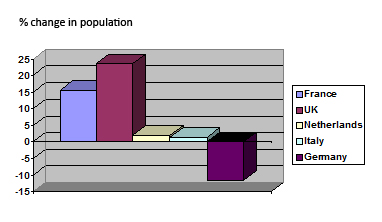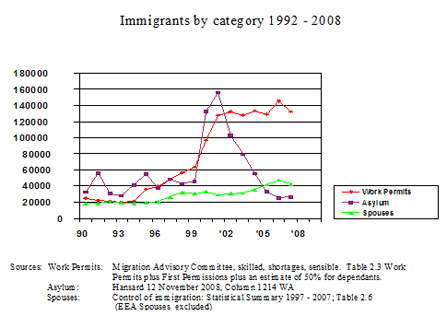How did immigration get out of control?
5 March, 2009
Summary
1 Government claims that the present very high levels of immigration to Britain are consistent with world trends in migration are misleading. Comparisons with other European countries are often irrelevant because of their quite different demography. These claims have been used as a smokescreen to disguise a series of policy failures which are the main reason why net foreign immigration has trebled since 1997.
World Trends
2 The government claim that the stock of migrants in the world has doubled since 1960 and that British experience is similar. The world stock has increased 2.5 times from 1960 to 2005. But world population itself has more than doubled since 1960, when it was just 3 billion, and a lot of migration is between the less developed countries. Globally, the percentage of world population who are international migrants has only increased from 2.5% in 1960 to 3.0 percent in 2005.
3 In Europe the migrant stock has increased from 3.4% of total population in 1960 to 8.8% in 2005. The graph below shows a rapid increase in the late 1980s and early 1990s. Much of this was caused by about 25 million former Soviet citizens of Russian ‘nationality’ finding themselves defined as foreigners in new states that previously comprised the Soviet Union. If this distortion was removed, the trend in Europe would be steady upward growth to something like 60 million.
4 This would contrast even more sharply with Britain where the greater part of the increase has arisen since the 1990s. The percentage of persons born outside the UK increased from 4.5% in 1961 to 5.8 % in 1991. It then doubled to 11% in 2008. As the graph below illustrates, the proportion of migrants in Britain accelerated rapidly from 1997.

Source: Population Division of the Department of Economic and Social Affairs of the United Nations Secretariat, Trends in Total Migration Stock: The 2005 Revision. Note: Data refer to censuses and other sources around the years indicated, not necessarily the exact year.
5 The government also suggests that the foreign born percentage in Britain is not far out or line with such countries as Canada, Australia and the US. These are very high by international standards, especially in Canada and Australia. They have for many years developed policies to attract immigrants; in Canada this has the specific aim of increasing the population by 1 per cent per year. This comparison also overlooks the fact that countries such as Canada and Australia were built on immigration and, far from being small islands, have immense land areas of which substantial parts are habitable.
Other countries in Europe
6 The stock of migrants in Europe has increased by 4½ times since 1960 but these figures are, as mentioned above, distorted by the consequences of the collapse of the Soviet Union. Since 1990 the increase has been only 30%.
7 Furthermore, both the history and the demographic forecasts for individual countries in Europe vary greatly. Germany imported a large number of guest workers from Turkey in the 1960s expecting them to return but many stayed and were joined by their families. France received large numbers from North Africa when those countries became independent in the 1960s. Britain never had a formal guest worker policy and net foreign immigration had fallen to a low level by the late 1980s. But in the decade from 1997 to 2006 net foreign immigration trebled from 107,000 to 317,000.
8 Demography is also widely different. Without immigration, Germany, Italy and Spain would decline sharply in numbers. France has a birth rate close to the replacement level, as does Britain. In Britain, immigration is projected to drive a rapid increase in population to 70m in 2028 and 77m in mid century. If immigration to Britain was bought into balance with emigration, the population would peak at about 64m in 2031 before returning to its current level of 61 million in about 2061.
Population of Selected EU Countries Projected To 2055 Without Migration Source: Eurostat 2008 convergence scenario

Population of Selected EU Countries Projected To 2055 With Migration Source: Eurostat 2008 convergence scenario

Government policy
9 Until 1997 it was the declared policy of successive British governments to minimise immigration into the UK subject to the needs of the labour market and obligations to dependants and international conventions. Indeed, until 1996 government statisticians assumed in their population projections that net immigration would be zero over the long term.
10 Since that period a series of policy measures has contributed to the rapid increase in immigration:
(a) Embarkation controls
Until 1994 a paper record was kept of foreign citizens arriving in and leaving from the UK. It was expensive and not very effective. In 1994 the Conservative government abolished these embarkation controls for destinations within the European Union. In 1998 the Labour government abolished these controls for the rest of the world. The effect was two fold. Foreigners arriving on time limited visas became aware that there was no check on their departure and, as Mr Blunkett later admitted on television, the government now has "no idea" who is in Britain
(b) The Primary Purpose Rule
Between 1983 and 1997 the "Primary Purpose Rule" imposed a requirement that the applicant should show "that the marriage was not entered into primarily to obtain admission to the United Kingdom". This was a major ground for refusing applications and dismissing appeals against refusal but it was controversial because it required the applicant to prove a negative. In 1997, shortly after the general election of that year, the rule was abolished. It is now possible, in practice, to enter into a marriage with someone settled in Britain purely for the purpose of immigration provided certain legal requirements are met. Immigration by spouses has increased by 50% since 1997.
(c) Asylum
The number of asylum claims rose very sharply from 1997 to 2002, reaching a peak of 84,000 in that year. Applications are now down to 26,000 a year but the loss of control of the asylum system contributed considerably to net immigration, particularly when dependants are included. The number whose claim is rejected still exceeds the number removed.
(d) Economic migration
Since about 2000, the present government have specifically encouraged the arrival of economic migrants. The number of work permits issued has trebled since 1997.
(e) Eastern Europe
Before our labour market was opened to the eight new member states of the European Union in May 2004 the government relied on a Home Office commissioned study which estimated that net migration from these countries would be between 5,000 and 13,000 a year. On that basis a maximum of 50,000 migrants could have been expected in the first four years. In the event, the labour force survey showed approximately half a million East European workers in Britain in mid 2008. In other words the forecast was wrong by a factor of at least 10.

Conclusion
11 The major increase in immigration to Britain has taken place since 1997. It is not a result of world trends but is largely the result of a series of policy errors and the deliberate promotion of economic migration. It follows that changes in policy can be expected to reduce the scale of migration to Britain.
Appendix / table
Population born abroad resident in Britain, 1901 – 2008
|
Population |
Percent |
Base |
Area |
Source |
|
born abroad |
born |
Population |
|
|
|
(millions) |
abroad |
|
|
|
Year |
|
|
|
|
|
2008 |
6.49 |
10.75 |
60.35 |
UK |
LFS |
2005 |
5.55 |
9.34 |
59.42 |
UK |
LFS |
2001 |
4.20 |
7.53 |
57.10 |
GB |
Census |
1997 |
4.08 |
7.00 |
58.31 |
UK |
LFS |
1991 |
3.15 |
5.75 |
54.89 |
GB |
Census |
1981 |
2.75 |
5.14 |
53.53 |
GB |
Census |
1971 |
2.39 |
4.55 |
52.56 |
GB |
Census |
1961 |
2.06 |
4.48 |
47.11 |
E&W |
Census |
1951 |
1.92 |
4.39 |
43.76 |
E&W |
Census |
1931 |
1.02 |
2.56 |
39.95 |
E&W |
Census |
1921 |
1.10 |
2.89 |
37.89 |
E&W |
Census |
1911 |
0.54 |
1.50 |
36.07 |
E&W |
Census |
1901 |
0.48 |
1.48 |
32.53 |
E&W |
Census |
Note: Born abroad means outside UK. NB Southern Ireland ceased to bepart of UK after 1921. The increase in 1921 is mostly due to the new inclusion of 281,000 persons born in the Irish Free State in the category ‘born abroad’. Data for ‘2008’ refer to 2007-8. Note also that some data refer to England and Wales, some to Great Britain and some to the UK. Most immigrants reside in England and Wales.
